10 best rigging for the stage
Finding your suitable rigging for the stage is not easy. You may need consider between hundred or thousand products from many store. In this article, we make a short list of the best rigging for the stage including detail information and customer reviews. Let’s find out which is your favorite one.
1. Stage Rigging Handbook, Third Edition
Feature
Used Book in Good ConditionDescription
2. Stage Rigging Handbook, Revised, 2nd Edition
Feature
Used Book in Good ConditionDescription
Stage Rigging Handbook is written in an at-a-glance outline form, yet contains in-depth information available nowhere else.
This second edition includes two new parts: the first, an expanded discussion of the forces and loads on stage rigging components and the structure supporting them; the second, an examination of block and tackle rigging. The remaining four parts contain numerous revisions.
Explaining his purpose, Jay O. Glerum points out that four main principles constitute the core of this book: know the rigging system; know that it is in safe working order; know how to use it; keep your concentration. Glerum applies these principles to all the major types of stage rigging systems, including block and tackle, hemp, counterweight, and motorized. He describes each type of rigging and then thoroughly reviews the operating procedures and ways of inspecting existing systems.
To provide background, Glerum opens with the basic theory of applied physics as it relates to rigging. Step by step, he explains the calculations required to determine safe working loads for various components. Glerums many anecdotes help the reader translate theory into reality.
Glerum then turns to four separate and detailed treatments of the main types of theatrical rigging. His thorough descriptions include drawings that identify each separate component of the rigging. He points out the advantages of each system, detailing everything from the mechanical advantage and the effects of wear on rope to the best ways to tie off the pin rail and to store weights. Because stagecraft often has been handed down orally from one stagehand to the next, incorrectas well as dangerousassumptions exist in the trade. Glerum provides a ready reference for everything from how to tie a knot to how to effectively communicate a warning for a runaway set.
Glerum also discusses special problems such as cutting fiber rope, terminating wire rope, attaching drops and framed scenery, using trusses and bridles, dead hanging, tripping, guiding loads, and other topics. He also covers recordkeeping, with tips and pointers on how to establish an inspection log.
3. Stage Scenery: Its Construction and Rigging
Description
Shows how to plan and manage the construction of sets, explains a variety of ways to build, handle, and shift scenery, and demonstrates useful painting techniques4. Entertainment Rigging for the 21st Century: Compilation of Work on Rigging Practices, Safety, and Related Topics
Feature
Focal PressDescription
From the basics of physical forces and mathematical formulas to performer flying and stage automation, Entertainment Rigging for the 21st Century provides you with insider information into rigging systems and the skills you need to safely operate them. Over the past decade, the entertainment industry has witnessed major changes in rigging technology, as manually operated rigging has given way to motorized systems in both permanent and touring productions, and greater attention has been paid to standardizing safety practices. This book leads you through what is currently happening in the industry, why its happening, and how. Accessible for riggers and non-riggers alike, it contains details on the technology and methodology used to achieve the startling effects found in concerts and stage shows.
With a foreword written by Monona Rossol, this text contains contributions from industry leaders including:
- Rocky Paulson
- Bill Gorlin
- Tray Allen
- Roy Bickel
- Keith Bohn
- Karen Butler
- Stuart Cox
- Bill Sapsis
- Dan Culhane
- Eddie Raymond
- Chris Higgs
- Carla Richters
- Joe McGeough
- Scott Fisher
5. Rigging Math Made Simple
Feature
Used Book in Good ConditionDescription
The job of an entertainment rigger is to safely suspend objects (scenery, lights, sound equipment, platforms, and even performers) at very specific locations above the ground. The type, size and location of the structural members from which these objects must be suspended vary greatly from venue to venue. Additionally, the size, weight, and location of each object varies from object to object. To ensure that each object is safely suspended at the proper location, math is essential. Sometimes this math is very simple, and sometimes it can be complex. One reason catastrophic failures occur is because the load placed on a structural member or a piece of hardware exceeds the breaking strength of the structural member or piece of hardware. While a structural engineer must determine the strength of the structural members, and the manufacturers determine the strength of the hardware, the rigger is responsible for knowing the forces that will be exerted on each rigging point and piece of hardware. Because the forces placed on each rigging point and piece of hardware are determined not only by the weight of the object (its static load) but also HOW the rigging is done, entertainment riggers must be able to calculate these loads/forces. There are plenty of entertainment riggers who do not know how to do much math - but these are the people doing exactly what they are told to do, and not the ones figuring out what to do and doing the telling. If you want to be a top-notch rigger, you have to know math.6. Dive Rite Scuba Diving Stage Bottle Rigging - 5 inches
Feature
For 5-inch diameter cylindersOne-inch (2.54 cm) nylon webbing strap with 2,200 lbs (998 kgs) tensile strength
Neoprene-infused elastic hose retainer band resists rolling, tearing and abrasion
Marine grade stainless steel cylinder clamps and hardware are saltwater ready and resistant to corrosion
One-inch (2.54cm) tubular webbing, provides diver/tank clamp abrasion protection (Tank Not Included)
Description
Dive Rite's Stage Bottle Rigging comes with everything a diver needs to correctly set up secondary bottles for years of technical diving. Our 1-inch (2.54 cm) nylon webbing with 2,200 lbs (998 kgs) tensile strength forms the carrying strap. Resistant to breakage, rot and splitting, nylon webbing creates a durable and long-lasting foundation for stage rigging, yet can be cut free in case of entanglement. Rugged EPDM rubber hose retainer band resists rolling and tearing and has the right amount of stretch. A large webbing loop on the retainer is easy to grip even with gloves on. Marine grade stainless steel cylinder clamps and hardware are saltwater ready and resistant to corrosion. (Tank Not Included)7. Nobody Looks Up: The History of the Counterweight Rigging System: 1500 to 1925
Description
Nominated for the 2016 USITT Golden Pen Award "...a magnificent and very important piece of work for our industry." Richard Pilbrow, author of 'A Theatre Project' "Very nice job, congratulations!" Mike Murphy, President, J.R. Clancy, Inc. "Boychuk has thrown down the gauntlet with bold statements backed up by documentation..." Tim Williamson, Northern Alberta Jubilee Auditorium "...a very informative and great read." Norbert Muncs, Past President, CITT "Anyone who has ever pulled a rope in the name of theatre will enjoy this revealing back story..." Charles Haines, President, Hall Stage Ltd. ~~~ The counterweight rigging system has dominated the theatre fly tower for the last half of the 20th century. And yet, the history of its evolution has been lost, until now. In this first ever written history of the counterweight rigging system, author Rick Boychuk upends two core theatre myths. Stage rigging did not grow from a nautical tradition and counterweight rigging did not evolve from the hemp system. Boychuk neatly identifies the origins of the myth of the sailor-flyman and leaves no room for doubt. Counterweight rigging emerged from a European tradition of 17th century Torellian stage machinery. Hemp rigging was a side-show. In documenting the evolution of the counterweight system, Boychuk dissects the machine that is the stage house along with its upper machinery the rigging. He examines the development of the fly tower, gridiron, loft steel, head steel, grid wells, arbor, bricks, blocks, and loft lines; all of those mundane components necessary to make the system work. He deconstructs hemp, counterweight and Torellian rigging into system paths to gain a better understanding of the progression of development and the workings of each system. This is the surprising story of how the counterweight rigging system was developed for an Austro-Hungarian theatre in 1888, then quickly found its way to the American Midwest in Adler & Sullivan's Chicago Auditorium in 1889. But it was the Chicago scenic painting studio Sosman & Landis that capitalized on the system. As Boychuk explains, Sosman & Landis adapted the system to increase the number of painted scenic pieces that they could sell to the well-funded Masonic theatres that were fast emerging across the United States. By 1925, the system had further evolved then to become crystallized in the catalogues of J.R. Clancy of Syracuse, NY. Clancy did for counterweight rigging what Ford had done for the automobile. Counterweight rigging was made affordable, was standardized and, soon, was ubiquitous in theatres around the world. A major takeaway from this book is this: the stage house impacted the evolution of stage machinery, and stage machinery impacted the evolution of the stage house. Today we appear to be witnessing a move from manual to automated stage machinery. If that is so, how will the change in our machinery impact our stage house? And how would we manage such a transition? Nobody Looks Up: The History of the Counterweight Rigging System: 1500 to 1925 is a must-read for all who work in and around technical theatre - stagehands, crew, manufacturers, designers, suppliers, consultants, and most importantly, those who are teaching the next generation of technicians. R.W. (Rick) Boychuk has been student, teacher, technical director, IA stagehand, designer and recently, inventor, and now an author. A graduate of University of Saskatchewan in technical theatre, he has worked in the industry for over 40 years. Rick owns and operates Grid Well, Inc. in Toronto, Ontario, Canada.8. Stage Scenery Its Construction and Rigging
9. Stage Rigging Handbook, Third Edition by Jay O. Glerum M.A. B.A. (2007-04-18)
10. Stage scenery: its construction and rigging













Recent Comments